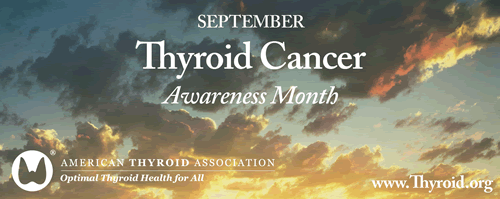
Clinical Thyroidology for the Public summarizes selected research studies discussed in the previous month’s issue of Clinical Thyroidology, an official publication of the American Thyroid Association. Editor-in-chief, Alan Farwell, MD, FACE
Volume 18 Issue 9
Available in pdf format for saving and printing and Web page format for viewing online
PDF Format for Saving and Printing
Clinical Thyroidology for the Public Volume 18 Issue 9 (PDF file, 2.37 MB)
TABLE OF CONTENTS – Web Format
HYPERTHYROIDISM
Who gains the most weight after hyperthyroidism treatment?
People with hyperthyroidism often lose weight before treatment because the thyroid gland makes too much thyroid hormone, which speeds up metabolism. After treatment, many patients regain lost weight, and some may gain more than the weight they had lost and become overweight or develop obesity. This study was done to better understand weight changes after treatment and find out which factors make some people more likely to gain a lot of weight after treatment of hyperthyroidism.
Kyriacou A et al. Severity of thyrotoxicosis is a risk factor for excessive weight gain in treated hyperthyroidism. Eur Thyroid J 2025;14(3):e240373; doi: 10.1530/ETJ-24-0373. PMID: 40238086.
THYROID CANCER
Do CT scans increase the risk of thyroid cancer?
CT scans are helpful, but they give off radiation, which could potentially damage cells and lead to cancer. The thyroid gland is sensitive to radiation and many CT scans include imaging the neck where the thyroid gland is located. In this study, doctors wanted to find out if more CT scans mean more risk of thyroid cancer, especially in children and adults who get scans of the head, neck, or chest.
Smith-Bindman R et al. Projected lifetime cancer risks from current computed tomography imaging. JAMA Intern Med 2025;185:710-719.
HYPOTHYROIDISM
Does treatment of hypothyroidism depend on your age, sex, or insurance status?
Hypothyroidism had previously been estimated to occur in 4.6% of population in the United States. However, recent studies have reported that hypothyroidism is now diagnosed much more frequently, up to 11.7% of the populations studied. With the increase in the number of patients with hypothyroidism in the U.S., this study aimed to describe treatment patterns of hypothyroidism across the United States using NHANES and the Optum Claims Database, a database of commercial insurance claims.
Tessnow AH et al. Treatment of hypothyroidism by age and sex in the United States: a NHANES and Optum Claims data analysis. Endocr Pract 2025;31(3):359-365; doi: 10.1016/j. eprac.2024.12.004. PMID: 39667670.
THYROID CANCER
Quality of life in patients with low-risk thyroid cancer undergoing active surveillance
Recent data has shown that small thyroid cancers are at a very low risk for growing and spreading outside of the thyroid. Because of this, the option of active surveillance is becoming a more common option for thyroid cancer patients. This study examined the factors driving treatment decisions and compares quality-oflife outcomes over time.
Kim MJ, et al. Comparison of patient-reported outcomes between active surveillance and immediate lobectomy in patients with low-risk papillary thyroid microcarcinoma: initial findings from the KoMPASS cohort. Thyroid 2024;34(11):1371-1378; doi: 10.1089/thy.2024.0264. PMID: 39287055.
THYROID FUNCTION TESTS
Should there be personalized reference intervals for thyroid function tests?
The normal ranges of thyroid function tests (TFTs) are generated based on the distributions of results from a healthy population without thyroid problems. One concern about the interpretation of TFT results is that they are a “one-size-fits-all” model, meaning that the normal ranges are applied equally during all ages of life regardless of sex, and race, all factors that a known to alter TFTs. This study examines 2 population-based TFT data sets with the aim of creating more individualized TFT reference ranges and determining their expected effects on the diagnosis of abnormal thyroid status.
Li Q, et al. Thyroid function reference intervals by age, sex, and race: a cross-sectional study. Ann Intern Med. Epub 2025 May 6; doi: 10.7326/ANNALS-24-01559. PMID: 40324200.
HYPOPARATHYROIDISM
TransCon PTH: a promising treatment for chronic hypoparathyroidism
Hypoparathyroidism is a condition marked by low calcium levels in the blood, usually caused by surgery involving the thyroid or head and neck, where the parathyroid glands may be accidentally damaged or removed. TransCon PTH (palopegteriperatide) is a new treatment for chronic hypoparathyroidism. The current study evaluated the effectiveness and safety of TransCon PTH in patients with chronic hypoparathyroidism
Clarke BL, et al. Efficacy and safety of TransCon PTH in adults with hypoparathyroidism: 52-week results from the phase 3 PaTHway trial. J Clin Endocrinol Metab. Epub 2024 Oct 8.



